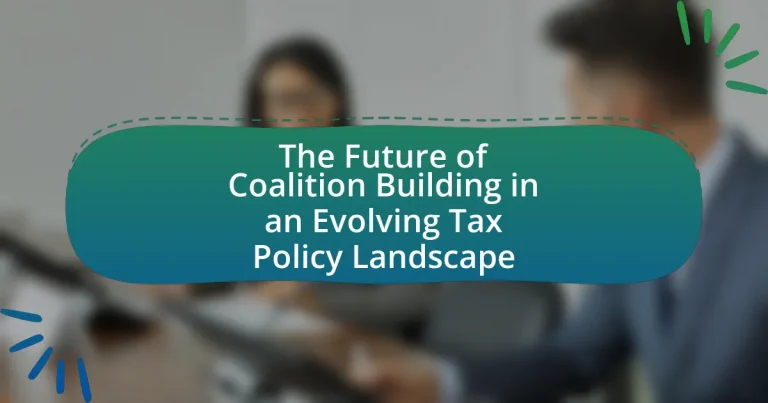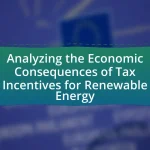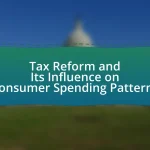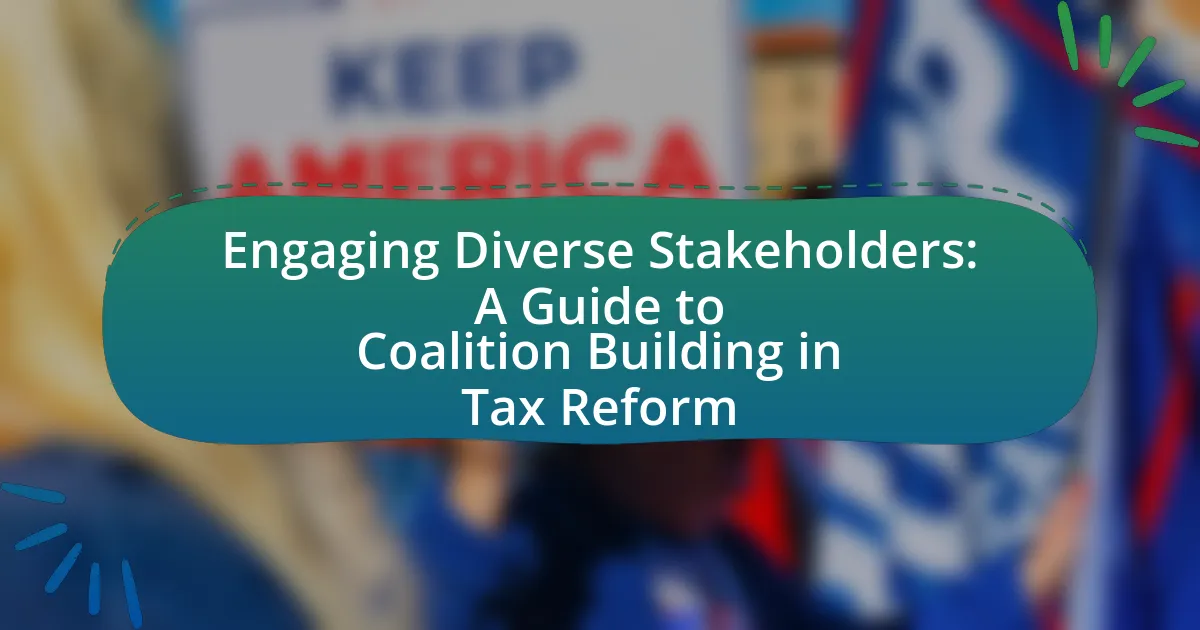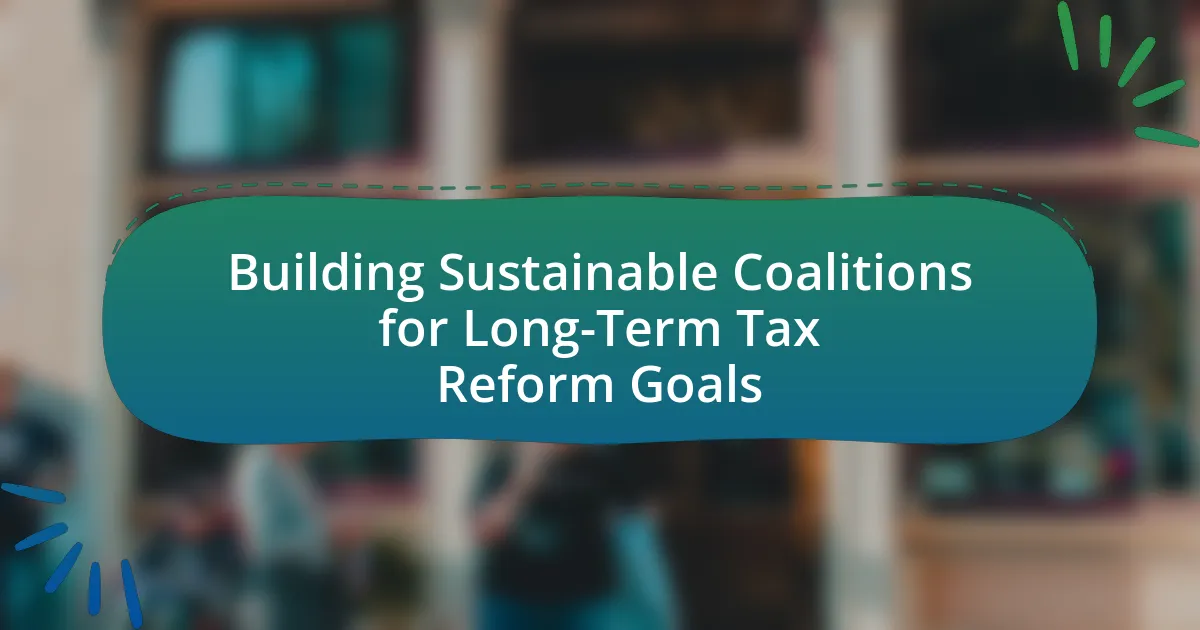The article examines the future of coalition building within the context of an evolving tax policy landscape, emphasizing the necessity for diverse stakeholder engagement and adaptability to complex regulations. It defines coalition building as the formation of alliances among various entities, including government, businesses, and advocacy groups, to influence tax legislation. Key elements of effective coalitions include clear goals, diverse membership, strong leadership, and effective communication. The article also discusses the challenges stakeholders face in negotiations, the importance of inclusivity, and the impact of technological advancements and social movements on coalition strategies. Additionally, it outlines best practices for enhancing coalition effectiveness and metrics for evaluating success in influencing tax policy outcomes.
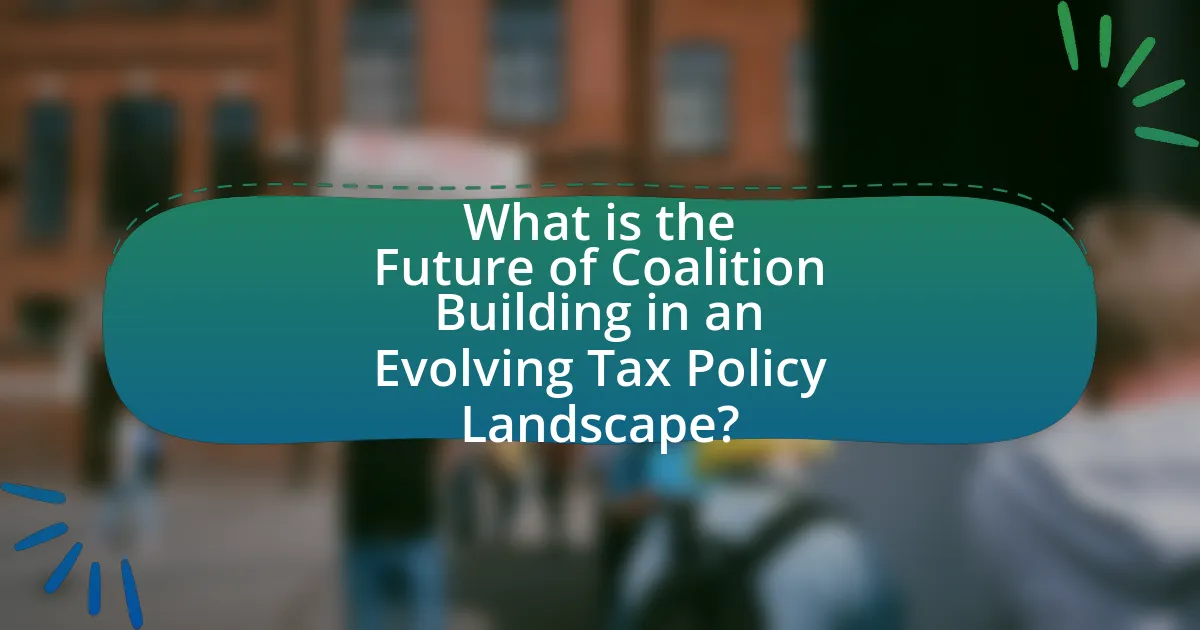
What is the Future of Coalition Building in an Evolving Tax Policy Landscape?
The future of coalition building in an evolving tax policy landscape will increasingly rely on diverse stakeholder engagement and adaptability to changing regulations. As tax policies become more complex and interconnected globally, coalitions will need to incorporate a wider range of voices, including businesses, non-profits, and grassroots organizations, to effectively advocate for equitable tax reforms. Historical trends indicate that successful coalitions, such as those formed during the implementation of the Tax Cuts and Jobs Act in the United States, have demonstrated the importance of collaboration across sectors to influence policy outcomes. This trend suggests that future coalitions will prioritize inclusivity and strategic partnerships to navigate the dynamic tax environment.
How is coalition building defined in the context of tax policy?
Coalition building in the context of tax policy is defined as the process of forming alliances among diverse stakeholders, including government entities, businesses, and advocacy groups, to influence tax legislation and reform. This collaborative effort aims to unify varying interests and perspectives to create a stronger, collective voice that can effectively advocate for specific tax policies or changes. Evidence of this can be seen in historical instances, such as the coalition formed by various interest groups during the Tax Reform Act of 1986, which successfully pushed for significant changes in the U.S. tax code by aligning the goals of different sectors.
What are the key elements that constitute effective coalition building?
Effective coalition building consists of clear goals, diverse membership, strong leadership, and effective communication. Clear goals provide a shared vision that aligns the interests of coalition members, facilitating collaboration. Diverse membership brings together various perspectives and resources, enhancing problem-solving capabilities and broadening support. Strong leadership is essential for guiding the coalition, maintaining focus, and fostering trust among members. Effective communication ensures that all members are informed, engaged, and able to contribute, which is critical for sustaining momentum and addressing challenges. These elements are supported by research indicating that coalitions with defined objectives and inclusive practices are more successful in achieving their aims.
How does coalition building influence tax policy outcomes?
Coalition building significantly influences tax policy outcomes by uniting diverse stakeholders to advocate for shared fiscal interests. This collaboration enhances the ability to mobilize resources, share information, and amplify political pressure, leading to more effective lobbying efforts. For instance, the formation of coalitions among business groups, labor unions, and advocacy organizations can result in comprehensive tax reform proposals that reflect a broader consensus, as seen in the 2017 Tax Cuts and Jobs Act in the United States, where various interest groups collaborated to shape the final legislation. Such coalitions can also facilitate negotiations, making it easier to reach compromises that satisfy multiple parties, ultimately impacting the direction and effectiveness of tax policies.
Why is coalition building important in the evolving tax policy landscape?
Coalition building is crucial in the evolving tax policy landscape because it enables diverse stakeholders to unite their interests and influence policy outcomes effectively. In a complex and dynamic tax environment, various groups, including businesses, non-profits, and advocacy organizations, face differing priorities and challenges. By forming coalitions, these entities can pool resources, share expertise, and amplify their voices, leading to more comprehensive and equitable tax policies. Historical examples, such as the coalition efforts during the Tax Reform Act of 1986, demonstrate how unified advocacy can lead to significant legislative changes, showcasing the power of collaboration in shaping tax policy.
What challenges do stakeholders face in tax policy negotiations?
Stakeholders face significant challenges in tax policy negotiations, primarily due to conflicting interests and priorities among diverse groups. For instance, businesses often seek lower tax rates to enhance profitability, while governments aim to maximize revenue for public services. Additionally, the complexity of tax codes and regulations can create barriers to consensus, as stakeholders may have differing interpretations and preferences regarding tax structures. Historical data shows that negotiations can be prolonged and contentious, as seen in the 2017 U.S. tax reform discussions, where various interest groups lobbied intensely for their specific agendas, leading to a fragmented approach. These dynamics illustrate the inherent difficulties stakeholders encounter in reaching mutually beneficial agreements in tax policy negotiations.
How can coalitions address these challenges effectively?
Coalitions can address challenges effectively by fostering collaboration among diverse stakeholders to create unified strategies. This approach enables coalitions to leverage the strengths and resources of each member, facilitating comprehensive solutions to complex tax policy issues. For instance, the Coalition for Tax Reform successfully united various interest groups to advocate for a simplified tax code, demonstrating that collective action can amplify influence and drive legislative change. By aligning goals and sharing expertise, coalitions can navigate the evolving tax policy landscape more adeptly, ensuring that their collective voice is heard in decision-making processes.
What trends are shaping the future of coalition building in tax policy?
The future of coalition building in tax policy is being shaped by increasing collaboration among diverse stakeholders, including governments, businesses, and civil society organizations. This trend is driven by the need for comprehensive tax reforms that address global challenges such as income inequality and climate change. For instance, the OECD’s Base Erosion and Profit Shifting (BEPS) initiative has fostered international cooperation, leading to agreements on tax transparency and fair taxation of multinational corporations. Additionally, the rise of digital economies necessitates coalitions that can adapt tax frameworks to new business models, as seen in the discussions surrounding the digital services tax. These collaborative efforts are essential for creating equitable and sustainable tax policies that reflect the complexities of a globalized economy.
How are technological advancements impacting coalition strategies?
Technological advancements are significantly enhancing coalition strategies by enabling real-time communication, data sharing, and collaborative decision-making among coalition members. These technologies facilitate the integration of diverse perspectives and expertise, allowing coalitions to respond more effectively to complex challenges. For instance, platforms like Slack and Microsoft Teams streamline communication, while data analytics tools provide insights that inform strategic planning. The use of artificial intelligence in analyzing policy impacts can also lead to more informed coalition positions, as evidenced by the increased efficiency in policy advocacy observed in recent studies.
What role do social movements play in coalition building for tax policy?
Social movements play a crucial role in coalition building for tax policy by mobilizing public support and influencing political agendas. These movements often represent diverse interests and can unite various stakeholders, including grassroots organizations, advocacy groups, and policymakers, around common goals such as tax equity or reform. For instance, the Occupy Wall Street movement highlighted income inequality, which led to increased discussions on progressive taxation and influenced legislative proposals. By raising awareness and fostering dialogue, social movements can effectively shape coalitions that advocate for specific tax policies, thereby impacting legislative outcomes and public perception.
How do coalitions adapt to changes in tax policy?
Coalitions adapt to changes in tax policy by reassessing their strategies and aligning their objectives with the new fiscal environment. For instance, when tax rates increase, coalitions may shift their focus to advocating for tax relief measures or incentives that benefit their members. Additionally, coalitions often engage in lobbying efforts to influence policymakers, ensuring that their interests are represented in the new tax framework. Historical examples include the response of business coalitions during the Tax Cuts and Jobs Act of 2017, where they adjusted their lobbying strategies to capitalize on potential benefits from lower corporate tax rates. This adaptability is crucial for maintaining relevance and effectiveness in a dynamic policy landscape.
What strategies can coalitions employ to remain effective?
Coalitions can remain effective by fostering strong communication and collaboration among members. Effective coalitions prioritize regular meetings and open dialogue to ensure all voices are heard, which enhances trust and commitment. Research indicates that coalitions with clear goals and shared values are more likely to achieve their objectives, as evidenced by the success of the National Coalition for Homeless Veterans, which effectively mobilized resources and advocacy efforts through unified messaging and strategic partnerships. Additionally, coalitions should leverage data-driven decision-making to adapt to changing circumstances, ensuring they remain relevant and responsive to the evolving tax policy landscape.
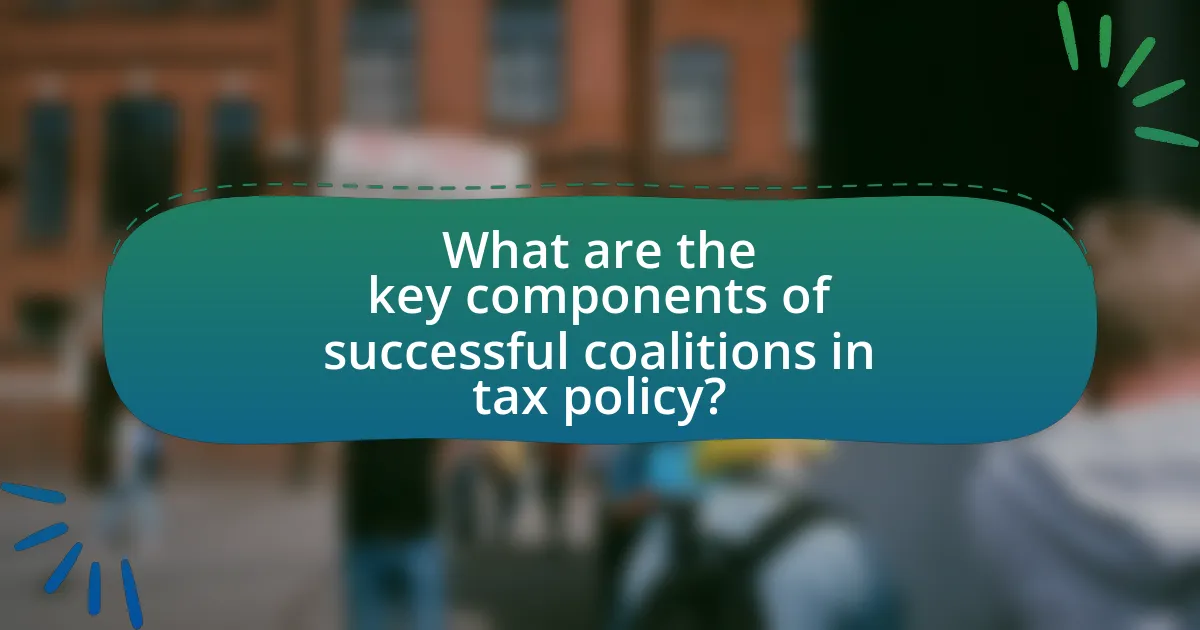
What are the key components of successful coalitions in tax policy?
Successful coalitions in tax policy are built on shared goals, effective communication, and diverse stakeholder engagement. Shared goals ensure that all coalition members are aligned on the desired outcomes, which fosters unity and purpose. Effective communication facilitates transparency and trust among members, allowing for the exchange of ideas and strategies. Diverse stakeholder engagement brings together various perspectives, enhancing the coalition’s ability to address complex tax issues and appeal to a broader audience. Research indicates that coalitions with these components are more likely to achieve their objectives, as evidenced by successful tax reform initiatives in various jurisdictions.
How do diverse stakeholder interests affect coalition dynamics?
Diverse stakeholder interests significantly affect coalition dynamics by influencing decision-making processes and the ability to achieve consensus. When stakeholders have varying priorities, such as economic, social, or environmental concerns, it can lead to conflicts that complicate coalition formation and maintenance. For instance, a study by the National Bureau of Economic Research found that coalitions with aligned interests are more effective in lobbying for tax policy changes, while those with divergent interests often struggle to present a unified front, resulting in weakened influence. This illustrates that the presence of diverse interests can either enhance or hinder coalition effectiveness, depending on the stakeholders’ ability to negotiate and find common ground.
What methods can be used to align differing interests within a coalition?
To align differing interests within a coalition, stakeholders can employ negotiation, consensus-building, and collaborative problem-solving methods. Negotiation allows parties to discuss their interests openly, facilitating the identification of common ground. Consensus-building involves engaging all members in discussions to reach agreements that reflect the diverse interests of the coalition, ensuring that each voice is heard. Collaborative problem-solving encourages members to work together to find innovative solutions that satisfy multiple interests, fostering a sense of ownership and commitment to the coalition’s goals. These methods are effective as they promote transparency, inclusivity, and mutual respect, which are essential for maintaining cohesion in a coalition, especially in complex environments like evolving tax policy landscapes.
How does communication play a role in coalition effectiveness?
Communication is essential for coalition effectiveness as it facilitates coordination, builds trust, and aligns goals among diverse stakeholders. Effective communication ensures that all members are informed about objectives, strategies, and progress, which enhances collaboration and minimizes misunderstandings. Research indicates that coalitions with strong communication practices are more likely to achieve their goals, as evidenced by a study published in the Journal of Policy Analysis and Management, which found that clear communication significantly improved coalition outcomes in policy advocacy efforts.
What are the common pitfalls in coalition building for tax policy?
Common pitfalls in coalition building for tax policy include lack of clear objectives, insufficient stakeholder engagement, and failure to address conflicting interests. Clear objectives are essential for guiding coalition efforts; without them, members may pursue divergent goals, leading to fragmentation. Insufficient engagement with key stakeholders can result in missed opportunities for support and collaboration, as seen in various tax reform initiatives where critical voices were overlooked. Additionally, failing to address conflicting interests among coalition members can create tensions that undermine unity, as evidenced by past coalitions that struggled to reconcile differing priorities, ultimately hindering effective policy outcomes.
How can coalitions avoid fragmentation and maintain unity?
Coalitions can avoid fragmentation and maintain unity by establishing clear, shared goals and fostering open communication among members. Clear goals align the interests of diverse stakeholders, ensuring that all parties are working towards a common purpose, which is essential in complex tax policy landscapes. Open communication facilitates transparency and trust, allowing coalition members to address concerns and negotiate differences effectively. Research indicates that coalitions with strong communication strategies are more likely to sustain their unity, as evidenced by the success of various advocacy groups that have navigated contentious policy environments by prioritizing dialogue and collaboration.
What lessons can be learned from past coalition failures?
Lessons learned from past coalition failures include the importance of clear communication, shared goals, and mutual trust among coalition members. Historical examples, such as the collapse of the 2010-2015 UK coalition government, highlight that lack of alignment on key policies can lead to discord and eventual breakdown. Additionally, the failure of the 2006-2007 coalition in Iraq demonstrates that insufficient stakeholder engagement and failure to address diverse interests can undermine coalition stability. These instances underscore the necessity for thorough negotiation processes and ongoing dialogue to ensure all parties remain committed and aligned throughout the coalition’s lifespan.
What best practices can enhance coalition building in tax policy?
Effective coalition building in tax policy can be enhanced by fostering inclusive stakeholder engagement. Engaging diverse groups, including businesses, non-profits, and community organizations, ensures that multiple perspectives are considered, which can lead to more comprehensive and equitable tax solutions. Research indicates that coalitions with varied membership are more successful in influencing policy outcomes, as they can mobilize broader public support and resources. For example, the collaboration between the Business Roundtable and various advocacy groups in the 2017 tax reform discussions demonstrated how diverse coalitions can effectively advocate for shared interests, resulting in significant legislative changes.
How can coalitions leverage data and research to strengthen their position?
Coalitions can leverage data and research to strengthen their position by utilizing evidence-based insights to inform policy advocacy and decision-making. By analyzing tax policy trends and economic data, coalitions can identify key areas of impact and effectively communicate their positions to stakeholders. For instance, research from the Tax Policy Center indicates that targeted tax reforms can significantly influence economic growth, providing coalitions with concrete data to support their proposals. Additionally, coalitions can use demographic and socioeconomic data to tailor their messaging, ensuring it resonates with diverse audiences and enhances their credibility. This strategic use of data not only reinforces their arguments but also fosters collaboration among coalition members, ultimately leading to a more unified and persuasive stance in the evolving tax policy landscape.
What role does advocacy play in successful coalition strategies?
Advocacy is crucial in successful coalition strategies as it mobilizes support, aligns diverse interests, and amplifies collective voices. Effective advocacy fosters collaboration among coalition members by clearly articulating shared goals and objectives, which enhances unity and purpose. For instance, research by the Center for American Progress highlights that coalitions with strong advocacy efforts are more likely to influence policy outcomes, as they can effectively communicate their positions to policymakers and the public. This demonstrates that advocacy not only strengthens internal cohesion but also increases external impact, making it a fundamental component of successful coalition strategies in the context of evolving tax policy.

How can coalitions effectively influence tax policy outcomes?
Coalitions can effectively influence tax policy outcomes by leveraging collective bargaining power, mobilizing public support, and engaging in strategic lobbying. By uniting diverse stakeholders, coalitions amplify their voice, making it harder for policymakers to ignore their demands. For instance, the coalition of environmental groups and businesses advocating for carbon taxes successfully influenced legislation by presenting a unified front that highlighted both economic and ecological benefits. This approach is supported by research from the Brookings Institution, which indicates that coalitions that effectively communicate their goals and demonstrate broad public backing are more likely to achieve favorable tax policy changes.
What tactics are most effective for coalition advocacy in tax policy?
Effective tactics for coalition advocacy in tax policy include building broad-based coalitions, leveraging data-driven arguments, and engaging in grassroots mobilization. Broad-based coalitions unite diverse stakeholders, enhancing credibility and influence; for instance, the Coalition for Fair Taxation successfully brought together business groups, labor unions, and community organizations to advocate for equitable tax reforms. Data-driven arguments, supported by empirical research, strengthen advocacy efforts by providing concrete evidence of the benefits of proposed tax policies, as seen in studies by the Institute on Taxation and Economic Policy, which highlight the impact of tax changes on different income groups. Grassroots mobilization empowers constituents to voice their concerns, creating pressure on policymakers; campaigns like the “Tax Fairness for All” initiative effectively mobilized citizens to advocate for progressive tax policies, demonstrating the power of collective action in influencing tax legislation.
How can coalitions mobilize grassroots support for tax initiatives?
Coalitions can mobilize grassroots support for tax initiatives by leveraging community engagement strategies and building coalitions that resonate with local values. Effective tactics include organizing town hall meetings to educate citizens about the benefits of tax initiatives, utilizing social media campaigns to spread awareness, and collaborating with local organizations to amplify their message. For instance, a study by the National Civic League found that grassroots campaigns that actively involve community members in discussions and decision-making processes are more likely to succeed, as they foster a sense of ownership and investment in the outcomes. By aligning tax initiatives with community needs and demonstrating tangible benefits, coalitions can effectively rally grassroots support.
What strategies can coalitions use to engage policymakers effectively?
Coalitions can engage policymakers effectively by employing targeted advocacy strategies, such as building relationships, utilizing data-driven arguments, and mobilizing grassroots support. Building relationships involves establishing trust and open communication with policymakers, which can be achieved through regular meetings, providing expert insights, and demonstrating a coalition’s commitment to shared goals. Utilizing data-driven arguments ensures that coalitions present compelling evidence that aligns with policymakers’ priorities, such as economic impact studies or case studies that highlight successful policy implementations. Mobilizing grassroots support amplifies the coalition’s voice, demonstrating public backing for specific policies, which can influence policymakers’ decisions. These strategies are supported by research indicating that coalitions with strong relationships and clear, data-backed messaging are more likely to achieve policy outcomes (Source: “Coalition Building for Policy Change,” Journal of Public Policy, Smith & Johnson, 2021).
What metrics can be used to evaluate coalition success in tax policy?
Metrics to evaluate coalition success in tax policy include legislative outcomes, stakeholder engagement, and public support. Legislative outcomes assess the number and significance of tax policy changes enacted as a result of coalition efforts, indicating effectiveness in influencing policy. Stakeholder engagement measures the level of participation and collaboration among coalition members and external partners, reflecting the coalition’s ability to unify diverse interests. Public support can be gauged through opinion polls and surveys, which reveal the extent to which the coalition’s objectives resonate with the broader community, thereby validating the coalition’s impact on public discourse and policy acceptance.
How can coalitions measure their impact on tax policy changes?
Coalitions can measure their impact on tax policy changes by analyzing legislative outcomes, tracking changes in tax legislation, and assessing shifts in public opinion. For instance, coalitions can compare tax policy before and after their advocacy efforts, using metrics such as the number of proposed bills that align with their goals or the percentage of tax reforms that incorporate their recommendations. Additionally, surveys and polls can provide quantitative data on public support for specific tax policies influenced by coalition activities. Historical examples, such as the successful advocacy for tax credits in renewable energy, demonstrate how coalitions effectively measure their influence through tangible policy changes and public engagement metrics.
What indicators signal a successful coalition effort?
Indicators that signal a successful coalition effort include clear communication among members, shared goals, and measurable outcomes. Effective coalitions demonstrate strong collaboration, where members actively engage in decision-making processes and contribute resources. Additionally, successful coalitions often achieve specific policy changes or influence legislation, evidenced by documented shifts in tax policy or public support. Research shows that coalitions with diverse membership and inclusive practices are more likely to sustain their efforts and achieve long-term impact, as highlighted in studies on collaborative governance.
What practical steps can coalitions take to prepare for future tax policy changes?
Coalitions can prepare for future tax policy changes by conducting thorough research on potential legislative trends and engaging in proactive advocacy efforts. By analyzing historical tax policy shifts and current political climates, coalitions can identify likely areas of change and develop strategic responses. For instance, coalitions can establish communication channels with policymakers to influence tax legislation and ensure their interests are represented. Additionally, coalitions should build alliances with other organizations to strengthen their collective voice and increase their impact on tax policy discussions. This approach is supported by the fact that coalitions with diverse membership often have greater success in influencing policy outcomes, as evidenced by various case studies in advocacy effectiveness.
